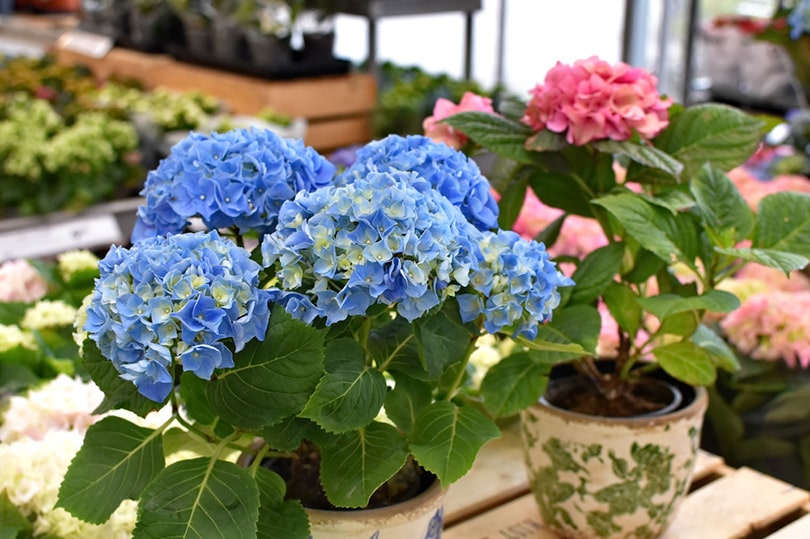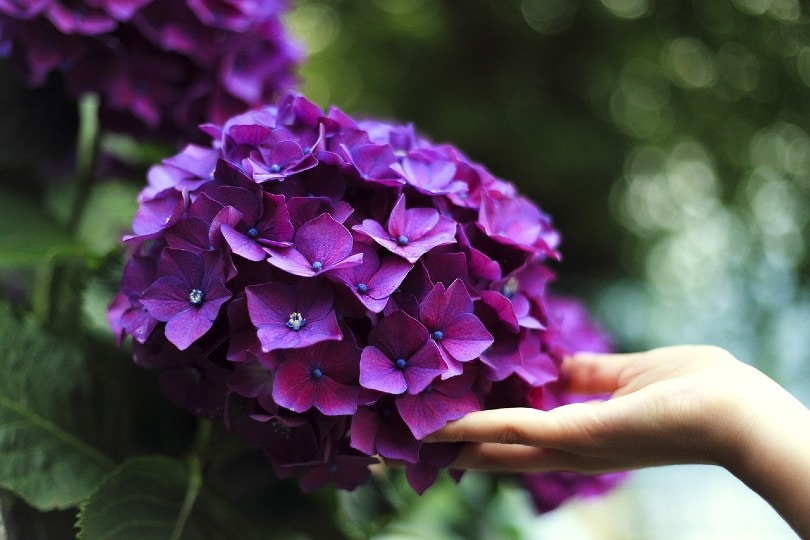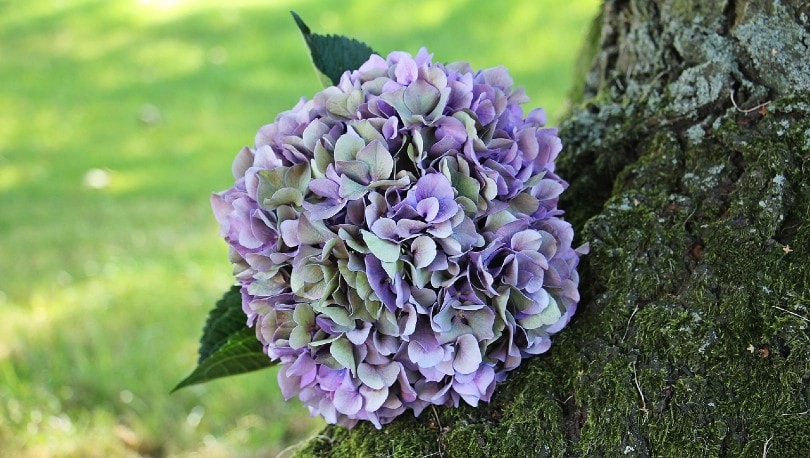How Much & How Often to Water Hydrangeas? Tips, Facts & FAQ
-
Visnja Radosavljevic
- Last updated:

Hydrangeas are stunning flowers that are easy to grow, making them a perfect addition to any garden. Although they are low maintenance, you need to learn how to take care of these plants for them to thrive. That includes providing the plant with everything it needs, but mainly with enough water.
Sometimes, finding the perfect watering schedule for hydrangeas can be challenging, so we wanted to provide more details about how much and how often to water them.
Keep reading to learn more about watering these flowers to help them grow healthy and strong.
Watering Requirements of Hydrangeas
Hydrangeas like water, but they can’t grow if the soil is too moist. Also, the watering requirements of hydrangeas can vary depending on several factors:
- Plant species: The species of your hydrangeas will affect its watering requirements. Some species like Mountain and Bigleaf need more water than others. However, if you want a drought-tolerant plant, Oakleaf or Panicle hydrangeas would be a better option
- Plant life stage: Established plants need less water than newly planted hydrangeas. The young plants need frequent watering to help them establish, which takes between 1–3 years.
- Location: Indoor hydrangea plants and hydrangeas in pots will need more frequent watering than outdoor hydrangeas.
- Soil condition: Having well-draining soil is essential for your hydrangea plants, as hydrangeas like water but don’t want to sit in soggy soil.
- Rainfall and climate: Most hydrangea varieties grow in USDA Hardiness Zones between 3–8. However, there can be minor alterations for specific species. Some varieties grow better in warm climates, while others succeed in colder climates. For example, your hydrangeas will need more water if you live in zone 7 or up because the climate is warmer.

How to Water Hydrangeas?
The life stage and location have the most significant impact on the watering needs of your hydrangeas. Because of that, newly planted hydrangeas are more high-maintenance than established plants. The same goes for indoor and hydrangeas in pots, which need more maintenance than outdoor hydrangeas.
Watering Frequency According to Life Stages
Newly Planted Hydrangeas
If you have newly planted hydrangeas, you’ll need to water them more until they establish roots. During summer months and drought, they might require daily watering as you need to prevent the soil from drying. It’s best to water the new hydrangeas three times a week while checking the soil.
That way, you can determine if you’re adding the proper amount of water or if you need to increase/decrease the watering frequency. You can also add mulch to retain more water and make your watering schedule less frequent.
Established Hydrangeas
If you have established hydrangeas, they’ll need less water than the new plants, and their water needs will vary species by species. Varieties such as Mountain and Bigleaf need more water than other hydrangeas, while Oakleaf and Panicle are more drought-tolerant.
You can perform a soil test by pushing your finger inside the top layer. If the top 2 inches are dry, it’s time to water the hydrangeas again. By repeating the watering process, you can determine how long it takes for the soil to get dry, and establish your watering routine.

Watering Frequency According to Location
The watering frequency can also vary according to the location of your hydrangeas. Indoor plants and plants in pots are typically needier than outdoor plants.
Indoor Hydrangeas
If you plant hydrangeas indoors, they’ll need more light, and more water to thrive. Usually, your indoor hydrangeas need watering once every couple of days. That can also vary depending on the temperature inside your home, as hydrangeas in warmer homes will need more water than those in colder homes.
Outdoor Hydrangeas
If you have outdoor hydrangeas, it won’t be difficult to take care of them. All you’ll need to do is water them every couple of days by giving the soil a good soak. That way, the water can reach all roots instead of being stuck at the surface. It’s also beneficial to add a layer of mulch as it has good water retention properties.
Hydrangeas In Pots
When you plant hydrangeas in pots, they’ll require more water than hydrangeas growing in the ground. As pots are typically small, they can’t retain the same amount of water as the ground. The good side of growing hydrangeas in pots is that you’ll be able to ensure your plant has proper drainage.
To provide the proper care to your hydrangeas in pots, water them every other day, but track the soil to ensure it doesn’t get soggy.
Tips for Watering Hydrangeas
There are a few useful tips for watering hydrangeas that will help you determine the right time to water your plants:
- Water thoroughly and deeply
- Add mulch to retain moisture
- Use a slow-release fertilizer
- Perform soil tests
- Look for signs of overwatering/underwatering

Possible Issues When Watering Hydrangeas
One of the biggest issues you can face is that you can easily overwater them. While hydrangeas like moisture, they need adequate, well-draining soil. Otherwise, overwatering would cause rot. Similarly, if you don’t water your plant enough, it could showcase symptoms of underwatering.
Some of the most common indicators of overwatering and underwatering are pretty similar. The key to avoiding these is to track how long it takes for the soil to dry and make your personal schedule to water the hydrangeas.
Overwatering
If there’s an issue with overwatering, your plants will display multiple symptoms, including:
- Yellow leaves
- Brown leaves
- Root rot
- Moldy smell
Your hydrangeas could even die from overwatering, so it’s crucial to stop watering if you notice any of the symptoms. You could also replant your hydrangeas into fresh soil to help them recover. Once the top 4 inches of the soil are dry, you can start watering again.
Underwatering
Another common issue is underwatering, and when your hydrangea plants don’t get enough water, some of the symptoms can resemble overwatering. Commonly, you’ll notice:
- Droopy leaves
- Yellow leaves
- Brown leaves
- Dry soil
It’s much easier to recover your hydrangeas from underwatering than from overwatering. If your plants lack water, all you need to do is to water them.
- See also: Is My Hydrangea Dead or Dormant?
Conclusion
There’s no precise answer to how much and how often to water hydrangeas, as the watering frequency varies due to several factors. However, most hydrangeas typically need between one and three waterings per week to grow healthy and strong.
- “Growing and Caring for Beautiful Hydrangea Flowers”
- “Watering Hydrangeas”
- “How Much and How Often Should You Water Hydrangeas?”
- “Watering 101: Everything You Need to Know For Happy Hydrangeas”
- “How Much Water Do Hydrangeas Need?”
- “How Often Should I Water My Hydrangeas?”
- “How Often Should You Water Hydrangeas?”
Featured Image Credit: ChiemSeherin, Pixabay
Contents
